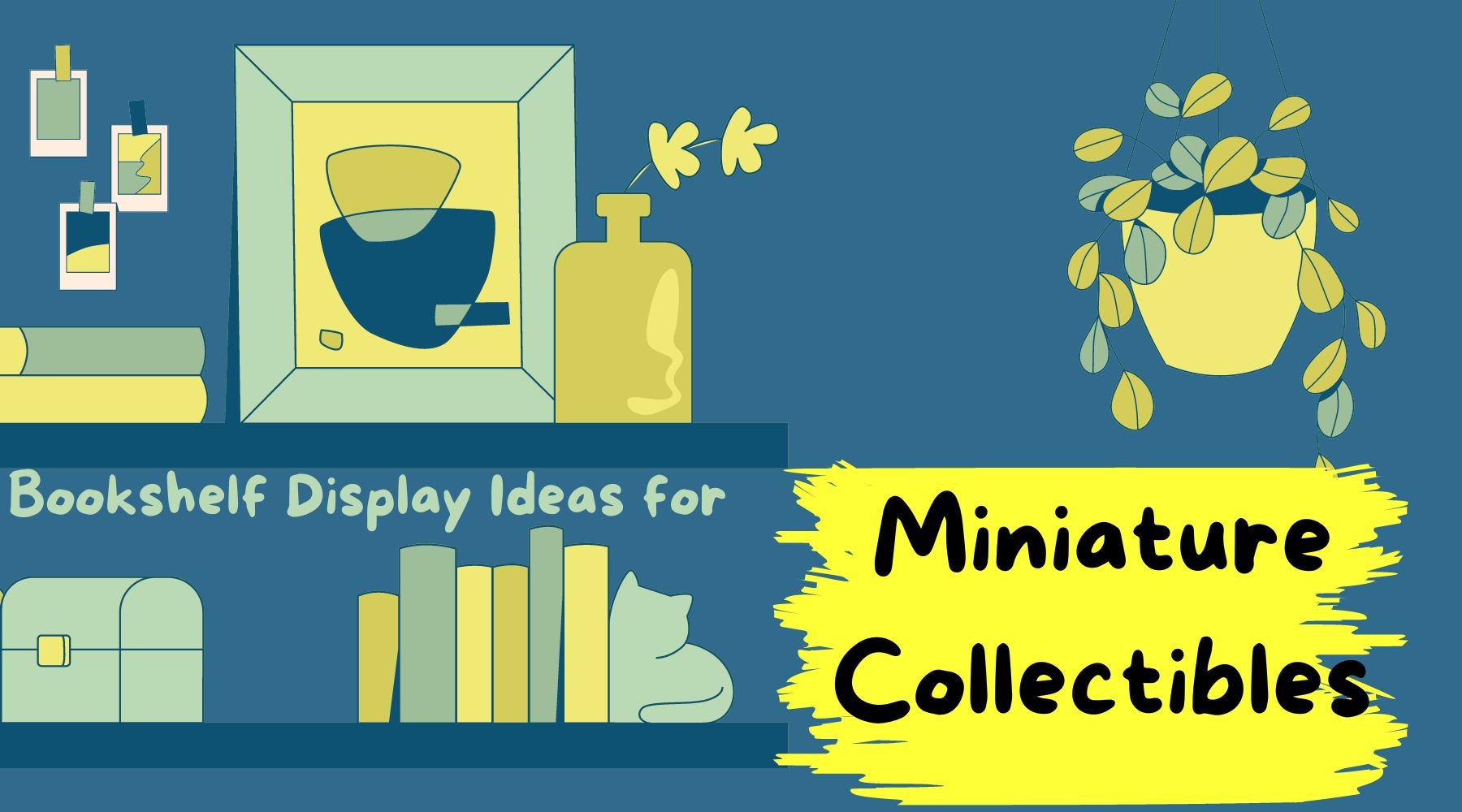For such small creations, displaying miniature collectibles can become an almighty puzzle once you’ve amassed several dozen pieces. There are display cases intended for protection and presentation, but that comes at a cost. Use what you have… you may be pleasantly surprised at some of the ultra-unique ways you can use miniatures to create awesome wall décor on and around your bookshelves.
Discover 7 Ways to Display Miniature Collectibles On (and Around) Bookshelves
1. Acrylic Cases

Fictional image generated by A.I.
Display cases come in all sorts of sizes. There are completely transparent acrylic cases you can buy that are the perfect size for miniature figurines. In some ways, acrylic is better than glass. For one, it doesn’t have the age-old problem of glare or the green tint that glass can have. Regardless of which angle you look at miniatures inside an acrylic case, the view will be clear. For the artistic among us, you can get creative by creating 3-dimensional scenes by either painting directly on the acrylic or sticking decorative scenic paper around the inside of the acrylic case.
2. Vintage / Reclaimed Printers Drawers

Image credit: Travis Nep Smith | CC by-NC 2.0
In the image above, a vintage printer drawer/tray has been used to create a table with separate compartments for storage. The same can be done for wall displays. Old wooden printer trays make the perfect display cases for miniature collectibles because it’s kind of what they were designed for. Back in the day, printer presses used little letters for typeset printing. The trays were made to have small compartments to store each letter. Today, they are becoming more popular among tech-free hobby enthusiasts for miniature display stands and parents looking for display cases for their kids' tiny toys, be they toy cars, action figures, or Lego figures.
Given the size and weight of printer trays, they won’t fit on a bookshelf, so hang them above it. In that respect, think of printer trays as shadow box frames to display miniature collectibles inside individual compartments. If you want added protection to prevent anything from falling off or to keep them protected from elements like dust and grime, you could attach sheets of acrylic glazing over the front, essentially turning it into a shadow box frame. As the trays are made of wood, they’re also easily painted to blend in with your décor.
3. Glass domes, balls, or snow globes

Image credit: Joachim S. Müller | CC by-NC-SA 2.0
Anything glass or transparent makes a good candidate for display cases. A few of those are glass domes, glass balls, and snow globes. Glass domes are the tallest and you can get Victorian-style domes that have the gold decorative plates on the base. More modern versions tend to have thinner bases in a solid color and are made of plastics rather than metal bases These are handy for displaying figurines. For the smaller trinket-size miniatures, glass balls like those used to make lightweight hanging terrariums with succulents would be suitable for smaller miniature collections. Once the interiors are designed and the figures inserted, they can be hung from a bookshelf. Another option is to make a DIY snow globe, or just borrow the concept and leave the glitter and liquid out.
4. Make a tiered display

Tiered displays let you use more of your bookshelf space without figures at the front blocking the view of those behind. You can buy a tiered display stand like the clear acrylic ones used to store bottles of nail polish, or stick with crafts supplies and use a wood-crafted tiered display stand that’s designed to display miniature collections together.
5. Make a diorama or a book nook

Book nooks are like enclosed dioramas. They’re narrow, and designed to slot between books on a bookshelf. DIY book nook kits offer the simplest way to get started. For displaying miniatures, given that book nooks aren’t very wide, there’s little room to display miniature collections. Dioramas though, can, and unlike book nooks, which you can only see the view from the front, dioramas are open-sided. You can create simple dioramas with foam blocks or wood, and design it to create a scene that suits your miniature collections. For example, a collection of miniature farm animals could be displayed in a field with a post and rail fence and faux grass. Zoos could be made with lions, zebras, monkeys, rhinos, giraffes, etc. Dioramas of cities, towns, or villages could have Playmobil or Lego figures along with miniature figures, automobiles, bicycles, and lighting. When mixing scale models, it helps to keep the sizes similar just for perspective. Dioramas and book nook kits can be made with or without using the same scale model ratios.
6. Expand your shelf space with floating sneaker shelves

Fictional image generated by A.I.
There are all types of shelves and displays. One that lends itself well to displaying miniature collections around bookshelves are floating sneaker shelves. They can be clear acrylic, colored, or illuminated with LED strip lights, with some changing colors too. Rather than losing precious bookshelf space, you can expand it with smaller floating shelves that can be affixed right beside a bookshelf, beneath, above, or surrounding it. Each shelf is large enough to fit an adult-sized shoe. That’s room enough for a lot of miniatures. Enough space to segregate your collections into groupings.
7. Build bases to transform miniature collections into statues

Miniature bases are used by creators to keep miniature figures upright. The styles can be as simple as flat plastic discs with the miniatures glued onto them or you can get creative and make stands, pedestals, or larger bases like crypts that can be decorated with wood carving or even a brass engraved plate attached to the base. Essentially, you can take one, two, or a few of your miniatures, build a made-to-measure pedestal, and turn a few miniatures into a stand-alone statue or monument.




Share:
Best Gifts for International Travel Lovers
DIY Bookshelf Insert Kits: Transform Bookshelves on a Budget